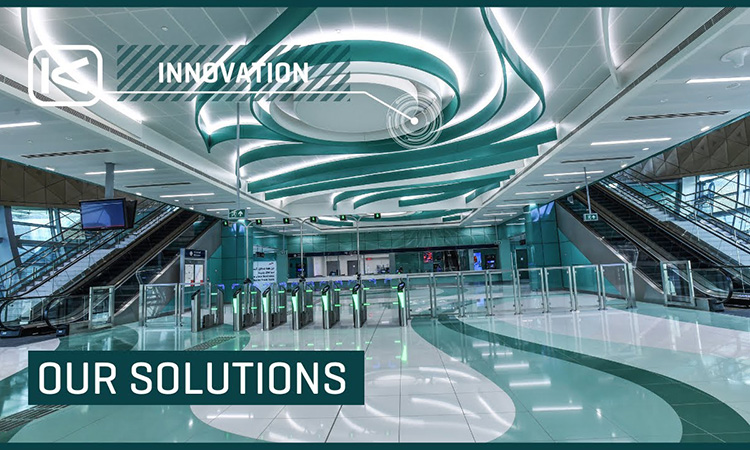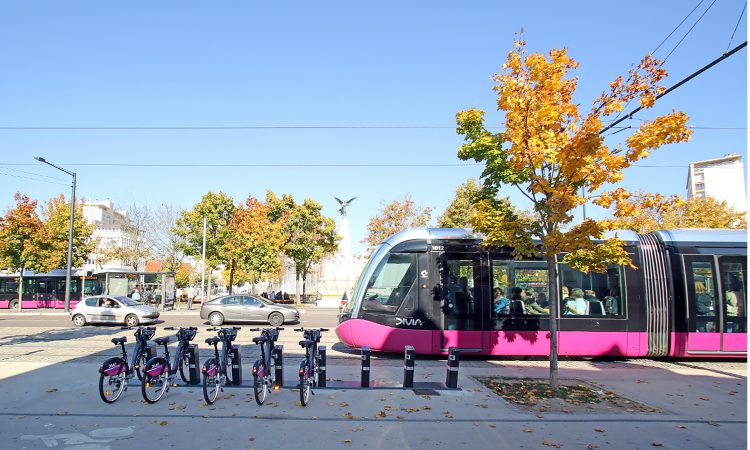Keolis Group’s pioneering role in redefining urban Mobility-as-a-Service
- Like
- Digg
- Del
- Tumblr
- VKontakte
- Buffer
- Love This
- Odnoklassniki
- Meneame
- Blogger
- Amazon
- Yahoo Mail
- Gmail
- AOL
- Newsvine
- HackerNews
- Evernote
- MySpace
- Mail.ru
- Viadeo
- Line
- Comments
- Yummly
- SMS
- Viber
- Telegram
- Subscribe
- Skype
- Facebook Messenger
- Kakao
- LiveJournal
- Yammer
- Edgar
- Fintel
- Mix
- Instapaper
- Copy Link
Posted: 6 February 2024 | Sandrine Gaubert - Keolis Group | No comments yet
While at Transport Innovation Summit 2023, Sandrine Gaubert, Customer Experience & Digital Marketing Director at Keolis Group, sat down with Intelligent Transport’s Halimah Haque to discuss how a tailored, passenger-centric MaaS offering is key in encouraging the shift to sustainable transportation.


What does Mobility-as-a-Service mean to you?
Mobility-as-a-Service (MaaS), for me, is a travel companion that helps to navigate within an integrated transport system and addresses key customer expectations in terms of simplicity, serenity, choice of travel and accessibility. This means that it has to be something that helps people to shift from their car to use public transport and additional active modes. It should not just be a technology or an app, but something that really helps people to travel sustainably.
MaaS… is a travel companion that helps to navigate within an integrated transport system and addresses key customer expectations in terms of simplicity, serenity, choice of travel and accessibility”
What does this mean, you may ask?
Simplicity means that, through one app or digital device, you can use your trip planner to identify the best possible route, book your ticket, pay for your ticket and travel. And, ideally, to have one single customer account if you are using the train, tram, buses or renting a car or bike.
Serenity is when you have strong benefits; for example, having access to real-time information, vocal guidance and information on potential disruptions, when you travel.
Choice is accepting that people have very strong diverse needs. For instance, when travelling with a pram, people want a transport mode which is really accessible, as they don’t want to navigate steps. People may want to travel for a very low price, so they are keen to understand what the price is that they will have to pay. Or, it could be something about the mode of transport, as people may prefer to travel by one particular mode over another. It could be about the duration of the trip, for instance, as people may prefer to have a longer trip with one single mode rather than by many connections to have a shorter trip. It is also about their own private, environmental mindset. If someone wants to reduce their emissions and carbon footprint, they may choose one solution over another.
Essentially, it’s about giving the passenger the choice, as we understand that we’re all different and have diverse needs with various factors impacting our decisions. As a public transport operator, Keolis has the responsibility to offer a service personalised to everyone whatever their behaviour, attitude and expectation.
How does Keolis Group contribute to the development and implementation of MaaS solutions?
We help PTAs to design their integrated transport system… because the network design should address the local expectations of the people, the local needs and local travel patterns”
Keolis Group operates more than 300 contracts with public transport authorities (PTAs) across the world. We have a strong duty to help our PTAs to build and design the best public transport system – an integrated one – to encourage people to shift from their car to public transport and active modes. There is a kind of urge on a global scale in terms of climate change and the increase in the temperature of the earth. So, what do we do? We help PTAs to design their integrated transport system by undertaking surveys and travel pattern analysis, because the network design should address the local expectations of the people, the local needs and local travel patterns.
The second thing is to provide a best-in-class travel information system, and we have our own in-house digital fabric, called Hove, which delivers a trip planner called Navitia, which is one of the most robust and well-known trip planners in the world. We work with a lot of PTAs who use it and, because we operate many networks around the world, we have lessons learned and share best practice among all of our PTAs.


Credit: Keolis Group – Keolis has its own in-house digital fabric, called Hove, which delivers a trip planner called Navitia.
You’ve briefly touched upon this, but can you provide some examples of specific MaaS initiatives or projects that Keolis Group has been involved in and what impact have they had on improving transportation options for users?
It is key to have in mind that we develop different levels of MaaS. So, it could be something very simple for a small territory or small PTA which still has a need in terms of a digital app, or bigger projects for larger metropolitan areas. An interesting project is in the city of Dijon, where we worked with Dijon Metropole. In this particular area, we manage a very large contract in terms of public transport, as we manage the tram, buses, bikes and car parks. It’s a unique contract to operate all of these modes on the behalf of the PTA. We have developed an app and, step-by-step, we are scaling functionalities and modes within this app. The next step is to integrate real-time information for regional trains and the recharge of the transport card.
This is a really interesting project: deciding priorities and tackling the best way to address these; and driving modal shift and changing behaviour towards the use of the private car. In Dijon, we have more than 125,000 users of the app and roughly 13,000 usages per day. It’s a great communication channel, as it’s a way to convey and explain the services to the people, then encourage them to buy and use public transport or other private transport, as well.
In Bordeaux, France, we operate a multimodal contract on behalf of Bordeaux Metropole; an integrated contract with tram, buses, on-demand services and bicycles, as well. And we integrate a free-floating system. In Bordeaux, they have built the mobility hub, so there is an existing app, similar to that in Dijon, that we are upscaling step-by-step.
We need to find the right balance between finding something that is standardised… and still creating something that is tailored and bespoke to the specific passenger needs of this particular territory”
The orientation in Bordeaux is really to work on the integration of what we call active modes. So, we encourage people to cycle and walk, with much of the focus around pedestrians. It’s a little bit different from Dijon, but what is key in both cases is that, whether you use the tram or the bus or free-floating or bikes, you have one single customer account. From the perspective of the customer, it should be very easy, very simple. You only register once and then you can use the different type of modes.
It should be seamless, simple and comfortable for passengers and every type of customer. But, behind the scenes, it’s very, very complex to interface the entire system in one unique application, balancing topics around data management, cyber-security, software robustness and, obviously, around the governance of the project. The public transport authority has a mammoth task to get all partners around the table and build commercial and contractual arrangements together. This is where Keolis can help – it’s what we are doing in Bordeaux and Dijon and most other places on the behalf of the PTA to build this system, to bring all partners together around the table and work on the solution.
It’s a lot about interface, data management, data sovereignty. It’s complex. It means that some mobility partners have to accept that we are handling the customer relations on their behalf. In terms of branding, it’s invisible. We promote the brand of the network. For instance, in Bordeaux it’s TBM, in Dijon it’s Divia, for all modes. So, we need to reach a consensus around the fact that only one brand is managing customer relations for all.
We need to find the right balance between finding something that is standardised – we don’t need to reinvent the wheel for something that we have done with success with another partner in another part of the world – and still creating something that is tailored and bespoke to the specific passenger needs of this particular territory.
It’s where the technology, interface and data touch. Yes, at some points it’s very complex; especially in the detail, as it’s the flow of the data, it’s the flow of the revenue, the flow of the payments that we touch when we are working on this particular MaaS system.
On that note, how does Keolis Group address the challenges of integrating various modes of transportation into the seamless MaaS platform?
Step-by-step, we always keep in mind that any MaaS platform should be customer-centric”
Usually, we have to make a plan with the PTA, who provide some orientation – their guidelines or objectives. And, with that, we have to build metrics where we put the modes that we would like to integrate and the functionalities that we would like to cover. We put in the different parameters and build it together step-by-step. First, we integrate public services – train, tram, metro, buses – then regional trains, car parks, taxis, walking, biking, free floating and so on.
The more you build the metrics, the more complex it becomes. Step-by-step, we always keep in mind that any MaaS platform should be customer-centric. We have to tackle where the true needs of the population lie. The ultimate design should be ergonomic, it should address the majority of their needs in a way that makes sense.


Credit: Keolis Group
What technological innovations and partnerships has Keolis Group pursued to enhance the user experience and accessibility of MaaS solutions?
We are working on innovating for the accessibility of our itineraries, in order to better guide and transport our passengers with reduced mobility”
As I touched on earlier, we have one in-house entity, Hove, which is developing and improving a huge trip planner called Navitia. So, Navitia is used by many PTAs in France, such as SNCF and Île-de-France Mobilités (IdFM). It’s a very powerful trip planner, integrating all modes of transport, providing different route alternatives, giving choice to the passenger through information. The planner can provide information about overcrowding on particular services or gas emissions; give people the choice if they travel with specific needs, like being in a wheelchair or travelling with a pram or pushchair; or indicate the cost of their trip – essentially, providing the passenger with choice through information. Navitia is a huge system, so it needs to be very robust when you have thousands, perhaps millions of requests in one day. It is a system which requires a robust back system that can manage the data appropriately. It is key to guarantee that the navigation within the app is intuitive and universal – no one should need a book to understand how it works.
We could say that Navitia could do everything you want, if you have the available data. However, this would depend on if the data is available and, more so, on the quality of the data. You won’t be able to tell people if the next tram is overcrowded or not if you don’t have that relevant data. Naturally, working with real-time information requires us to have strong processes in terms of managing that data.
In terms of innovation, we are working on innovating for the accessibility of our itineraries, in order to better guide and transport our passengers with reduced mobility. For example, in Rennes, we have been working with Handimap, an expert in collecting data on the accessibility of infrastructures and roadways in urban environments, to integrate this data into our multimodal trip planner Navitia, thus offering 100% accessible trips to our passengers. It is as detailed as avoiding big steps or choosing the widest pavements and directing them to our accessible public transport options.
What sustainability initiatives has Keolis Group undertaken within the field of MaaS and how do they align with broader environmental and social goals?
At Keolis, we consider these [active travel] modes to be essential and fundamental; we have to integrate them in the overall marketing strategy and network design”
MaaS is not the only thing that we can do to really drive modal shift. Like I said before, we have to first think of the citizens’ needs and expectations in that particular area, city or region when we talk about mobility. So, we develop surveys to understand these very aspects and to help the PTA to design a network which is attractive to everyone. We are also considering working on on-demand services. Sometimes, the focus is only on a city’s centre, but what happens when you are in a much more remote or rural area or neighbourhood? This is where on-demand services, which are totally integrated in the hub, come into play. As such, they may be key in connecting people from their home to the MaaS transit system.
We are also investigating working on what we call active travel modes, such as cycling and walking. At Keolis, we consider these modes to be essential and fundamental; we have to integrate them in the overall marketing strategy and network design, and then really encourage people to make them a part of their journey. The health and social benefits are clear for all to see. As a public transport operator, we have a social responsibility to work with the communities in term of network design, for instance, and so we value our consultation with communities.
When you talk about digital, it’s important to remember that a big majority of the population is still not totally at ease with digital. Certainly, smartphone uptake is very high, with around 70% of the population using an app to plan and/ or book their transport. At Keolis, we feel that it is important that people are able to find the information that they need and purchase a ticket without the use of an app. Equally, of those 70% using an app for their transport, not all will find that app easy to navigate and will explore its full functionality.
So, we maintain what we call more ‘regular’ channels of information, communication and distribution, like commercial agencies, automatic distribution, buying your ticket from the driver or open payment, for instance. We have to guarantee that you will find a solution, whatever you need and whatever your level of utilisation of a digital app.
Finally, what have you most enjoyed about speaking at and attending the Transport Innovation Summit?
The conference has been really insightful. I was on stage with someone from Brompton Bike Hire, a mobility partner focused much more on bikes and someone else from FREENOW. They are both very different people but have common goals, specifically on how we can shift people from their car to a more sustainable form of mobility. I have really enjoyed being here in London, this is only my second trip here and I’m very happy to be back – even in the rain!


Related topics
Accessibility, Active travel, Journey Planning, Micro-mobility, Mobility Services, Modal shift, Multimodality, Passenger Accessibility, Passenger Experience, Public Transport, Sustainable Urban Transport, Ticketing & Payments, Transport Innovation Summit 2023, Travel & Passenger Information
Related modes
Bikes & Scooters, Bus & Coach, Rail, Tram
Related countries
France, United Kingdom
Related organisations
Brompton Bike Hire, FREE NOW, Île-de-France Mobilités (IdFM), Keolis Group, SNCF
Related people
Sandrine Gaubert







